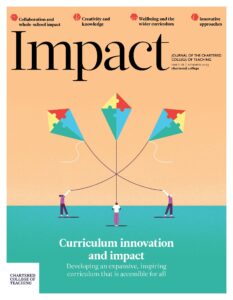Voice and authenticity: Applying student voice research to teaching oracy

- Curriculum |
- Diversity |
- Oracy
BATHSHEBA WELLS DION, ECT TEACHER OF ENGLISH, BRISTOL CATHEDRAL CHOIR SCHOOL, UK
‘I would like to build on what L and J said,’ says T. ‘I think maybe she used that kind of language because she felt small, and sometimes people want others to feel small, so they can feel bigger.’
T is talking about a character from a story called ‘Brownies’, by ZZ Packer, in the English and Media Centre’s Diverse Shorts collection. We are discussing why a girl in the story uses ableist language against another group of girls who have SEND, a group of girls whom she accused of calling her the N-word. T is in her first term of Year 7.
In a diverse class of Year 7s, we are talking (not with this terminology) about complex and sometimes debated ideas such as systemic racism, intersecting forms of oppression and the psychological impact of inherited trauma. There are no hands up. Since setting the discussion up, I have not said a word.
I started teaching last year, schooled on the benefits of student voice. It is suggested as a way in which to re-engage disaffected students, raise attainment and boost inclusionAn approach where a school aims to ensure that all children are educated together, with support for those who require it to access the full curriculum and contribute to and participate in all aspects of school life within schools (Mitra, 2018). So I tried to apply this in my classes, asking students their opinions, letting them choose which characters to write about and so on.
But there was a problem. Many students did not speak, and when they did their responses were limited by the questions that I set them.
Reading about student voice took me to Ralph and Levinson’s (2019) student interviews. They reframe voice from specific contexts – councils, surveys, student panels – to something always in progress in schools. Behaviours not typically read as expressions of voice (silence, non-compliance, truancy) are reread as meaningful communication by students about their views and experiences. For instance, students using drama spaces forbidden at lunchtime was reframed from rebellion against teacher instructions, to an attempt to reclaim space and agency in a school that they felt was trying to change them.
This encouraged me to take a more expansive view of voice. I wanted to listen to student voice in a way not directed and filtered by my own voice and approach to speaking. I wanted to cultivate an approach that recognised and validated the voices of students shaped in conversation with each other, not just in response to school systems.
In collaboration with my ECT mentor, we developed the following plan:
First, students need to know how to listen. This might seem a counterintuitive starting point when encouraging students to use their voices. But the skill to actively hear others – not just passively remain silent while they talk, but to take on their ideas and allow them to transform your own – is fundamental to dialogue. We used Voice 21’s listening ladder. This made the listening process visible to students, giving us a shared language for talking about positive listening behaviours. It holds students accountable for their behaviour; they cannot progress us up the ladder without being still and focused as a starting point.
Secondly, students need to know how to talk to each other. Again, this might seem counterintuitive when we want students to speak in ways authentic to themselves, but there is a difference between authenticity and rudeness. In increasingly diverse classrooms, we cannot assume that students have shared vocabularies with which to exchange ideas, so we need to create these. Table 1 contains example sentence stems that I taught students to help them to frame contributions respectfully and purposefully.
| Making a point
I would like to suggest… To introduce a new idea,… |
Building on ideas
Building on what______ said, I think… I agree with_____, because… |
| Challenging ideas
I have a different opinion to____, because… I disagree, because… |
Using evidence
The reason that I think this is because… Something to support that ideas is… |
| Interrupting
Could I add to that point, please? Would you like me to help support that point? |
Stopping interruptions
Please let me finish my point first. Before you say that, I would like to add… |
Table 1: Example sentence stems with which to frame respectful conversations
We practised throughout classroom activities: Have a point to add? You need to acknowledge the person on whose ideas you build. Disagree with what someone says? You need to challenge respectfully and justify with reasons. We built from small-group discussions to whole-class conversations that included everyone.
Then we talked. Once students had these tools, we gradually adopted a ‘no-hands-up’ policy for certain discussions, letting them decide who spoke and when. I decentred myself from the conversation; students spoke directly to each other, and not through me. They could speak with more agency and authenticity because they set the terms of the discussion. When they chose to speak, how they spoke and when they used silence or questions to add meaning – this was in students’ hands.
This is not perfect, nor without risk. Opening up the possibility that it is not the teacher’s place to set the terms of discussions opens space for students to challenge us and our role. It is also not a magic bullet with which to engage the most disengaged or resistant students. But these challenges hold me accountable in selecting and delivering content; I must prove to students why subject matter is important, and I need to build trust for them to feel safe sharing ideas in academic contexts.
In the English curriculum, particular voices and modes of speaking – notably those that use standard English and received pronunciation, and pertain to middle-class and often white British backgrounds – are valued over others. Valuing students’ voices and giving them spaces in which to express these in more authentic ways goes some way towards deconstructing notions about the ‘legitimacy’ of registers of speech. More expansive definitions of voice feed into broader movements around issues such as decolonisation (Glowach and Wells Dion, in press). Decentring ourselves as teachers can have a transformative impact on our students.
- Cook-Sather A (2006) Sound, presence, and power: ‘Student voice’ in educational research and reform. Curriculum Inquiry 36(4): 359–390.
- Glowach T and Wells Dion B (2023) Empowering student voice in discussions about race in literature. The Curriculum Journal 34(1): 108–110.
- Mitra DL (2018) Student voice in secondary schools: The possibility for deeper change. Journal of Educational Administration 56(5): 473–487.
- Ralph T and Levinson M (2019) Conflicting communication about the ownership and meaning of places in a school in South West England. In: Collins P, Igreja V and Danaher PA (eds) The Nexus Among Place, Conflict, and Communication in a Globalising World. London: Palgrave Macmillan, pp. 79–98.










